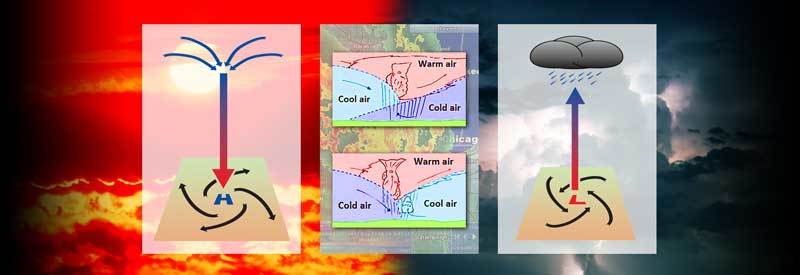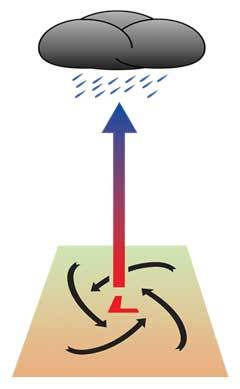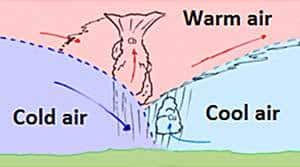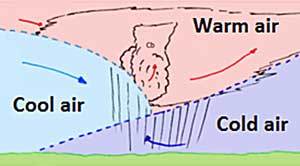11 Weather Terms And Phenomena You Should Know And Understand

For more than half a century, weather forecasts have helped us to plan for future weather conditions. However, eleven meteorological terms are especially useful to make the most sense of these forecasts.
- 1Low & High Pressure Systems
- 2Cold Fronts
- 3Warm Fronts
- 4Jet Streams
- 5Severe Weather
- 6Thunderstorms
- 7Dry Spells
- 8Wind Chill
- 9Heatwaves
- 10Tornadoes
- 11Climate Change
It is important to get to know and better understand these terms, as it will help you gain an even better understanding of how and why we are affected by different weather conditions.
Especially if you have your own personal weather station or are a weather enthusiast keen on better understanding how everything fits together, the following information will be especially useful.
We are going to discuss the 11 terms listed in more detail since they make up some of the most important and relevant weather terms and weather phenomena.
We start with some weather terms some of you may already be familiar with:
1) Low & High Pressure Systems
Low & high-pressure systems are probably one of the most well-known and widely-used terms in meteorology. We first need to understand what air pressure is before we can delve into low and high-pressure systems.

Air pressure is defined as the weight of the air molecules in a specific space pushing down on the surface below as a result of the Earth's gravity.
It can be seen as the number of molecules present in a certain volume of air at any given moment or a specific period of time.
Air pressure is created in a variety of different processes, which in turn leads to different changes in weather. This leads us to low and high-pressure systems.
What Is A Low-Pressure System?

A low-pressure system is defined as a specific area where the weight of the air (or amount of molecules present in this volume of air) is lower than that of the air in the surrounding areas.
The process through which a low-pressure system is formed is called cyclogenesis, which is the umbrella term for the different circulation processes involved in the formation of a low-pressure system.
(We don't need to look at all of them for the purpose of this article, though. Just know that the term "cyclogenesis" is representative of all these different processes.)
Development
For a low-pressure system to form, certain elements must be placed to cause a drop in air pressure. A low-pressure system is normally formed as a result of 2 different processes:
- Wind Divergence Aloft
- Thermal Lows
1) Wind Divergence Aloft
Wind Divergence Aloft causes the air in the upper troposphere to move in opposite directions, creating a suction effect that allows the air at the surface to start lifting.
(The effect counteracts the laws of gravity by creating a vacuum in the upper troposphere, which makes the lifting of the heavier surface air possible).
Low-pressure systems that are formed as a result of this effect mainly take place in 2 places:
- To the east of upper troughs (Which normally have long wavelengths)
- In front of shortwave troughs
2) Thermal Lows
Many of you familiar with tropical depressions (and the resulting tropical storms, hurricanes, cyclones, etc.) will be familiar with the way in which these low-pressure systems are formed.
As the surface of our oceans and landmasses are warmed up by the sun, it causes the air above it to heat up as well. The warmer air starts to rise, leaving less air at the surface, which causes a low-pressure system to occur as a result.
Characteristics Of A Low-Pressure System
Low-pressure systems are almost always associated with cloudy and rainy weather. (You only need to look at any weather forecast to notice how often a low-pressure system is mentioned in the same breath as cloudy & rainy conditions.) There is a good reason for this.
As the air above the low-pressure system continues to rise, it starts to cool down. As the moisture-carrying air cools down, condensation and cloud formation takes place, which normally results in precipitation.
As air normally flows from an area of high-pressure to low-pressure, winds tend to blow inwards towards the area of low pressure.
This inward circulation of air is influenced by the earth's rotation. This effect is more commonly known as the Coriolis Effect. As a result, the winds rotate clockwise around a low-pressure system in the Southern Hemisphere and counterclockwise around a low-pressure system in the Northern Hemisphere. (Also referred to as cyclonic flow.)
What Is A High-Pressure System?
A high-pressure system can be defined as a body of air which weight (or amount of molecules present in the volume of air) is more than that of the air in the surrounding areas.
Development

In many ways, a high-pressure system and its development can be seen as the direct opposite of a low-pressure system. This is especially evident in the way it is formed...
Warm air that has risen from the equator cools down, and the resulting precipitation dries out the air, which then starts moving towards the poles.
The cold, dry air from the upper troposphere starts descending (as the cooler air weights more than the surrounding warmer air). The air converges at the top of the high-pressure system, strengthening the descend of the cooler air.
As the cool air continues to descend, it starts compressing as well as it nears the surface level. This results in a high-pressure system forming where the descending air reaches the surface center of the weather system.
Characteristics Of A High-Pressure System
Low-pressure systems are normally associated with clear sunny weather and light surface winds. (The cool, dry air, combined with the air heating up as it descends, prohibits any formation of clouds and precipitation.)
As air always moves from an area of high pressure to low pressure, winds blow outwards and away from the center of the high-pressure system.
Just like low-pressure systems, the winds rotating around a high-pressure system are influenced by the Coriolis Effect (caused by the rotational spin of the earth).
Unlike low-pressure systems, though, the winds rotate in a clockwise direction around high-pressure-systems in the Northern Hemisphere and counterclockwise in the Southern Hemisphere.
2) Cold Fronts
A cold front occurs when the leading edge of a mass of cold air moves into a region of warmer air. The boundary between these two air masses is called a cold front. A cold front is normally associated with wet and stormy weather conditions.

This characteristic stormy weather that accompanies a cold front is a direct result of the "collision" between the 2 air masses. As the edge of this fast-moving cold air mass reaches the warmer air, the cold (and heavier) air undercuts and starts lifting the warmer (lighter) air up into the atmosphere.
As the warm air is lifted, it starts to cool down, causing the moisture in the air to start forming micro-droplets as a result of condensation. If enough moisture is present in the rising air, this will lead to cloud formation and precipitation.
Please note that this is a very broad description of a cold front. For example, a cold front that meets and lifts a body of warm air that carries little or no moisture may not display any of the normal characteristics associated with a cold front (e.g. rain, clouds, and wind).
Many different weather systems can be responsible for a cold front to form. We will discuss this in more detail in another article.
3) Warm Fronts
A warm front occurs when the leading edge of a mass of warm air moves into a region of colder air. The boundary where these two air masses meet is called a warm front.
A warm front is normally associated with slow-moving stratus-type clouds producing light rains for a sustained period of time. (Similar to a stationary front.)
As the warm air cannot replace the denser and heavier body of colder air, it is forced to rise and move over the boundary of the colder air mass. This process is called overrunning.

If there is enough moisture in the air (which is not always the case), the rising warm air will start to cool down as it moves up and over the mass of cold air. As a result, condensation and cloud formation will occur, which normally produces sustained light rain, often followed by a light drizzle later on.
As a warm front moves much slower than the more disruptive cold front, the weather changes associated with it are also more prolonged and not that severe. It is normally preceded by high forming clouds that slowly get replaced by lower cloud formations as the warm approaches.
The actual arrival of the warm front is normally accompanied by a sudden drop in air pressure. The light rain previously mentioned normally arrives with the cold front, and as the front passes over, it turns into a light drizzle.
As in the case of a cold front, the conditions described above are fairly broad characteristics of weather normally associated with a warm front. (As a result, a variety of different weather conditions can occur due to specific characteristics of a warm front, as well as the part of the word it occurs in.)
4) Jet Streams
Jet streams are defined as long narrow bands of strong winds, blowing at high velocities above the earth's surface, normally found in the upper troposphere at heights of 9 to 16 kilometers (30 000–52 000 feet) above sea level.
There are 4 major jet streams present above the earth's surface, and they all have a huge influence on the global climate and the formation of various weather systems.
The 2 strongest jet streams are found at the south and north pole, respectively, at heights of 9–12 kilometers (30 000–39 000 feet). The 2 weaker subtropical jet streams occur at a height of 10–16 kilometers (33 000–52 000 feet).
Jet streams are mainly formed as a result of 2 processes.
- Solar Radiation (the heating up of the atmosphere) resulting in the influential Hadley, Polar, and Ferrel circulation cells
- The Coriolis Effect (a result of the earth's rotation, affecting global air movement)
Not always moving in a straight line, but rather in a more meandering manner, as it moves between areas of hot and cold air, jet streams form a boundary between these pockets of warmer and colder air.
Jet streams are also influenced to a large extend by the difference in temperature between these areas of hot and cold air. A bigger difference in temperature between the warmer and colder air masses will result in a substantial increase in the velocity at which the jet stream is traveling.
Jet streams are especially important to the aviation industry and closely monitored by major players in the industry. Using jet streams flowing in the same direction a plane is traveling in is beneficial for saving fuel & reaching a destination on time (or making up lost time).
(Get it wrong, however, and airlines may end up with their planes flying directly into an opposing jet stream flow, leading to additional fuel being used and flights potentially arriving late at their destination.)
5) Severe Weather
Severe weather refers to any meteorological phenomena that are dangerous and potentially destructive. This can lead to severe damage, disruption of large areas of infrastructure, and even loss of life. This includes thunderstorms & lightning, hail, heavy rain & flooding, tornadoes, and severe wind conditions.

Depending on where on the planet you are situated, you will be affected by severe weather conditions that are common to that specific region.
For example, areas in India may be very susceptible to flash flooding due to the seasonal summer monsoon bringing with it huge amounts of rainfall.
Similarly, if you live in Tornado Alley (the area found in the Great Plains of the Central United States), you are more likely to suffer the devastating effects of tornadoes forming during the spring and summer months.
No matter where you find yourself, it is always important to pay attention whenever severe weather condition warnings are issued. You and your family's life may literally depend on it.
6) Thunderstorms
Thunderstorms are violent and fairly short-lived disturbances in the atmospheric conditions, normally associated with lightning and thunder, strong winds, heavy rains, and even hail. They are normally associated with & a result of a sudden buildup of cumulonimbus clouds.
For thunderstorms to occur, three key ingredients need to be present:
- Moisture
- A Lifting Mechanism (normally in the form of heat)
- An Unstable Rising Air Mass
With these 3 ingredients present, a thunderstorm will go through three phases of development to complete the process:
- Developing (Cumulus) Stage: Warm air with low pressure at the surface starts to rise. As it continues to rise, it cools down, and the moisture in the air condenses and form micro-droplets. If the air is unstable enough and continues to rise, it leads to the formation of cumulus clouds. Through a process of convection, the air is driven higher into the atmosphere by updrafts, creating a low-pressure zone.
- Mature Stage: The air continues rising until it reaches a region of warmer air, which stops it from rising any further. It starts spreading out horizontally, and large amounts of moisture combine to form large droplets. As they start falling, they cause downdrafts, which, combined with the updrafts, result in the formation of cumulonimbus clouds. This causes severe internal disturbances within the clouds, resulting in the severe conditions we commonly associate with thunderstorms.
- Dissipating Stage: At this stage, a process called a downburst can occur as the downdrafts overwhelm any more updrafts and air inflow into the thunderstorm. This process happens very rapidly as this downburst carries air quickly to the ground and then spreads out, after which the thunderstorm starts to dissipate relatively quickly.
You also get more than one kind of thunderstorm. Single-cell, multi-cell clusters, and Supercells are just a few well-known examples. (We will discuss these different types of thunderstorms in a separate article.)
There is one more important fact to take note of. Even though most thunderstorms look violent and spectacular, in order for them to be officially classified as severe thunderstorms, they need to fulfill the following criteria:
- Wind speeds of at least 93 kilometers per hour (58 mph)
- Hail with a diameter of 25 millimeters (1 inch)
- The presence of tornadoes
7. Dry Spells (As Opposed To A Drought)
A dry spell can be defined as a sustained period of dry weather with lower water and soil moisture levels due to a lack of rainfall. A region with significant lower rainfall figures during its rainy season compared to previous seasons can be regarded as experiencing a dry spell.

A dry spell should not be confused with a drought, however. There are much debate and confusion about the difference between the two, and depending on which region you find yourself on the planet, definitions may vary.
In general, a dry spell does not last as long as a drought. Although it puts a strain on natural resources, especially in the agricultural sector, it normally does not pose an immediate threat to human or animal life.
A drought, on the other hand, is a much serious condition with severe consequences. Probably the most important feature setting it apart from a dry spell is the length of time over which it occurs.
It can last over a multiple series of dry spells, sometimes taking years or decades to fully develop. The results are normally devastating. Water and resources depending on the water can be completely depleted.
Often this results in the destruction of the agricultural sector, the lifeblood of any country region. This will directly threaten the livelihood of the region's inhabitants and cripple the sustainability of all processes necessary for growth and survival.
As a result, one should be very careful to refer to sustained dry spells putting a strain on any region for a period of time as a drought.
(Something the news media is sometimes quick to jump on for dramatic effect, often causing undue panic in the process.) They may have similarities but are very different in their extent and level of seriousness.
8) Wind Chill
Wind chill (or wind chill factor) refers to the phenomena where you experience temperatures around you as much colder than it actually is due to the presence of wind. It is caused by wind blowing surrounding cold air against you, causing you to perceive temperatures as colder than it actually is.
You are experiencing the temperature to be that much colder because your body's natural heat creates a layer of warm air around your skin to provide a form of insulation from the surrounding cold air. Wind blowing against your skin, however, removes this insulation layer, making you experience the temperature to be much colder.
When you hear or read the term "feels like..." next to the temperature given, it refers to the wind chill "temperature" in case you were wondering.
9) Heatwaves
A heatwave refers to a period of prolonged exceptionally hot weather, often accompanied by high humidity levels. It is often determined when compared to the hottest average temperatures from the region during the same period measured during previous seasons.

The precise definition differs between different regions and different weather services. Sometimes this can lead to much confusion. (For example, in certain parts of Australia, a heatwave is defined by 5 consecutive days of temperatures exceeding 35 °Celsius (95 °Fahrenheit) or 3 consecutive days of temperature exceeding 40 °Celsius (104 °Fahrenheit).
The South African Weather Service again, define a heat wave as the maximum temperature in a specific area to be 5 °Celsius hotter than the average maximum temperature of the hottest month of that specific area for at least 3 consecutive days.)
As you would have noted from the 2 samples above, definitions can vary widely from one region to another. Rather than relying on specific numbers, the definition highlighted in bold at the start of this section should be considered to be a more accurate determination of a heatwave in your area.
Heatwaves are a result of the formation and strengthening of high-pressure systems in the upper atmosphere (3 000–7 600 meters or 10 000–25 000 feet). As weather patterns move much slower during the summer months compared to winter months, they tend to linger over a specific area much longer.
The air under the high-pressure system dries and warms as it is forced down and sinks towards the surface. This, in turn, forms an inversion layer, preventing convection from taking place and trapping the hot, humid air beneath it.
You can learn more about a heatwave in this article.
10) Tornadoes
A tornado is a funnel-shaped, rapidly rotating moving column of air. They normally form at the base of cumulonimbus clouds and can cause various degrees of damage, depending on the wind speeds' scale and strength.

Tornadoes are classified on a scale from F0 (the weakest form doing minimal damage) to F5 (the strongest form of the system able to rip houses clean off their foundation and do significant damage to infrastructures).
Wind speeds are normally around 180 km/h (110 mph) or less, but in Category F5 storms, wind speeds of over 450 km/m (300 mph) can be reached with catastrophic consequences. Tornadoes are also around 250 meters (80 feet) in diameter but can be as big as 3 kilometers (2 miles).
Tornadoes are formed due to a convergence of downdrafts and updrafts below a cloud base, which starts the rotating air movement. As the updrafts intensify, it causes an area of intense low pressure, which is pulled to the surface.
This results in the familiar funnel cloud with the section reaching the surface containing strong updrafts and high wind speeds, leading to severe damage often associated with strong tornadoes.
You can find in-depth information about tornadoes in this article.
11) Climate Change
As you will be very well aware, Climate Change is a very controversial topic and a subject for a whole series of articles on its own. Since it has been widely used over the past few decades in the same breath as global warming (with its different causes and its effect on the environment and the planet as a whole), an explanation of this term is warranted.
In a nutshell, climate change refers to the changes in the state of the earth's atmosphere over a period of at least 3 decades and more. This includes global temperature changes, the flow of our oceans' currents, and rainfall, to mention a few variables.
Climate change has gone through natural cycles of Global Warming and Ice Ages through millions of years during the earth's history.
What makes Climate Change that much more relevant and important to us is the unnaturally accelerated pace at which it is taking place now and the close ties with human intervention and the impact on the environment since the Industrial Revolution and our continued release of fossil fuels and gasses into the atmosphere.
But this is a topic for a whole other conversation.
Conclusion
11 Very important weather terms were addressed in this article. Hopefully, this will clear up many elements of the weather you were unfamiliar with.
You will note that some terminologies received a lot more attention and got explained in more detail than others. Those were the terms I regard as important to understand and will help you to better understand many other weather terms and occurrences.
Never miss out again when another interesting and helpful article is released and stay updated, while also receiving helpful tips & information by simply following this link .
Until next time, keep your eye on the weather!

